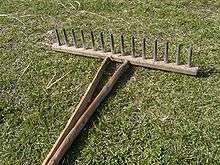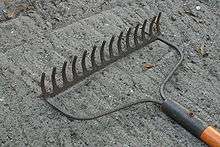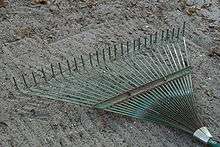Rake (tool)
A rake (Old English raca, cognate with Dutch raak, German Rechen, from the root meaning "to scrape together", "heap up") is a broom for outside use; a horticultural implement consisting of a toothed bar fixed transversely to a handle, or tines fixed to a handle, and used to collect leaves, hay, grass, etc., and in gardening, for loosening the soil, light weeding and levelling, removing dead grass from lawns, and generally for purposes performed in agriculture by the harrow.[1]



Large mechanized versions of rakes are used in farming, called hay rakes, are built in many different forms (e.g. star-wheel rakes, rotary rakes, etc.). Nonmechanized farming may be done with various forms of a hand rake.
Types of rakes
Modern hand-rakes usually have steel, plastic, or bamboo teeth or tines, though historically they have been made with wood or iron. The handle is often made of wood or metal. Some rakes are two-sided and made with dull blades in the shapes of slight crescents, used for removing dead grass (thatch) from lawns. When rakes have longer teeth, they may be arranged in the shape of an old-style folding fan.
Cultural associations
If a rake lies in the ground with the teeth facing upwards, as shown on the top picture, and someone accidentally steps on the teeth, the rake's handle can swing rapidly upwards, colliding with the victim's face. This is often seen in slapstick comedy and cartoons, such as Tom and Jerry and The Simpsons episode "Cape Feare", wherein a series of rakes become what Sideshow Bob describes as his "arch-nemesis". There is a Russian saying "to step on the same rake" (Russian: наступить на те же грабли), which means "to repeat the same silly mistake", also the word "rake" (Russian: грабли) in Russian slang means "troubles".
Heavy rake
This type of rake is for conditioning and dethatching soil as well as moving larger pieces of debris. Most weeds have weaker and shallower roots than grass and thus dethatching along with (afterward) necessary sunlight, fertilizer and seed, and if later necessary any remedial chemicals, makes for a good crop of grass. Larger tools (or lawnmower attachments) are more often used for large areas of de-thatching or soil preparation. However the action of making the soil bare and exposed to sun is not good and worms do not like it. It should be protected with straw afterward. Soil aeration tools do not remove weed but prepare soil without exposure.
Plastic or metal
There are pros and cons to each. Plastic rakes are generally lighter weight and lower cost. Because they can be fabricated in widths of greater dimensions they are more suitable for leaves which have recently been deposited. Metal tined rakes are better suited for spring raking when the debris is often wet or rotted and can best be collected when the metal tines penetrate to the thatch layer.
References
-

External links
![]()